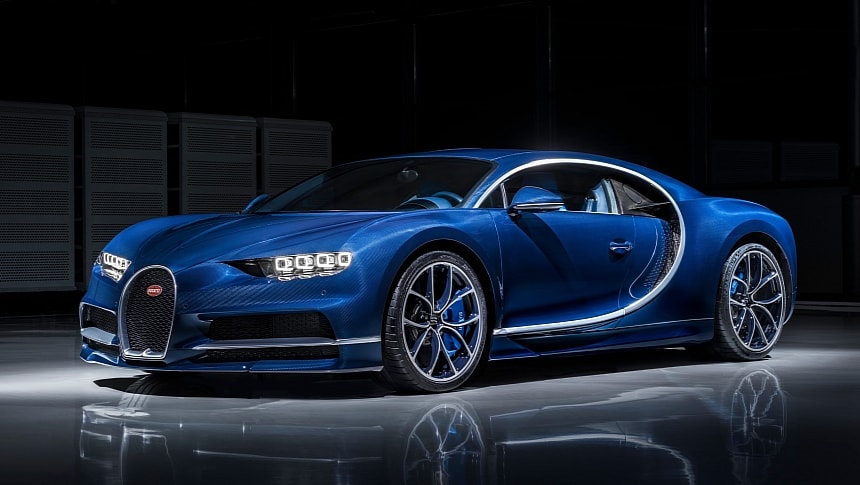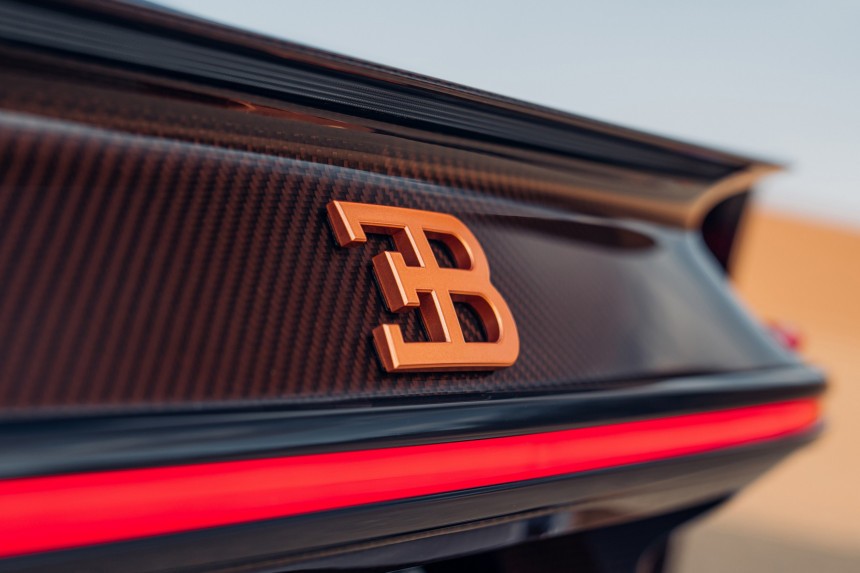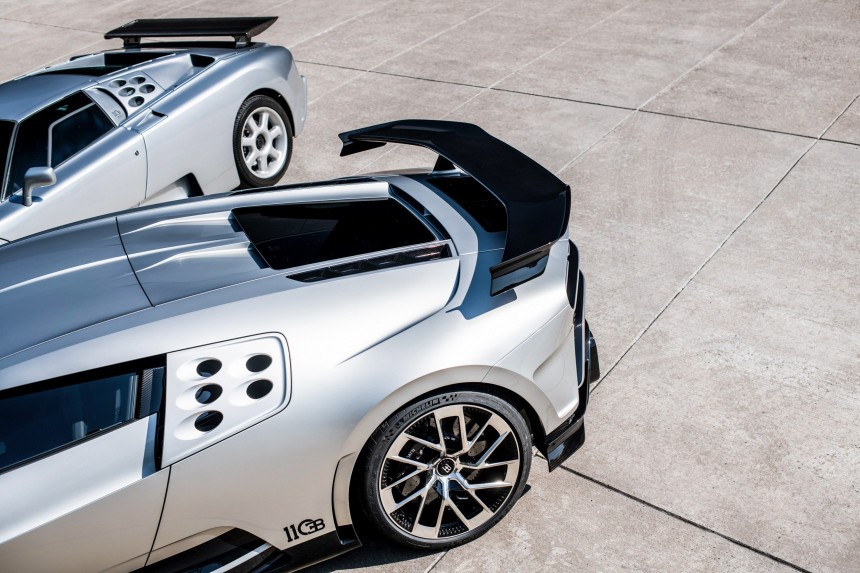Bugatti is renowned for creating some of the world's most incredible and exotic cars. Almost every vehicle out of Molsheim deserves a place in the Automotive Hall of Fame. Cars like the Bugatti Veyron brought about a revolution in hypercar technology. Among others, the Chiron, Divo, and Centodieci utilize carbon fiber in their production.
Carbon is one of the most abundant elements in the world, and carbon fiber is used extensively throughout the automotive world. Supercars and hypercars are often littered with lightweight material. Even performance-oriented family sedans like the Alfa Romeo Giulia Quadrifoglio use carbon fiber in the bodywork and internal components. There are a number of cars that have entire carbon fiber bodies.
Carbon fiber is the material of choice for sports cars or performance cars due to its lightweight and high-strength properties. Imagine if a bicycle was made from carbon fiber instead of steel, aluminum, or titanium; pedaling would take less effort.
Carbon fiber components can save up to 30% of weight over aluminum parts and up to 50% over steel. Sporty or track-focused cars need to tip the scales as low as possible, with every pound of weight compromising the performance, so it makes sense to design each car on a carbon fiber diet. Coupled with a powerful engine, that is a recipe for a thrilling driving experience.
Another advantage of the popular material is its strength; carbon fiber is stronger and more rigid than steel, so discerning customers are safer when driving cars with a high-performance powertrain.
Bugatti customers can choose from nine different tint colors and varying levels of visible carbon fiber, so it is possible to show off the expertise that goes into the production of the entire vehicle.
Bugatti insists, "Carbon fiber is not just functional – it is also beautiful." This is an integral part of Bugatti's 'Form Follows Performance' design philosophy since the Bugatti EB110 became one of the first production cars in the world to be fitted with a carbon fiber monocoque. The brand offers some of the most beautiful and intricate carbon fiber parts on their hypercars, but the creation process is truly fascinating.
A strict design team requirement is that every weave must be aligned at a 45° angle, with a perfect fishbone in the middle. Any carbon fiber weave that contains more than 1 or 2° of imperfection must be discarded and started again.
This is also the case if any bumps or kinks are found in the finish. The margin for error is mere millimeters, and quality control is paramount, especially since carbon fiber isn't cheap to produce. This is one of the reasons why carbon fiber isn't more widely available. Once the direction of the weave is established, together with a mold, it is baked under high pressure for a couple of hours in an autoclave at 248 °F (120 °C).
"Creating the perfect visible carbon fiber finish takes our expert craftspeople months to complete, and we strive to offer one of the widest ranges of tints and finishes in the industry," says Christophe Piochon, president of Bugatti Automobiles. He also highlighted the hard work that goes into the production process.
"The precision necessary to ensure thousands of fibers, perfectly created, to flow without interruption and at the ideal angle all across the car takes an enormous level of expertise, patience, and talent."
It takes an incredible amount of time and attention to detail to ensure the flow of the carbon weave is aligned perfectly with Bugatti's high standards. In particular, the engineers must achieve an optimum 'flushed gap' between all parts and components.
The flow of the material must exhibit visual satisfaction while upholding strength across the entire car. Since the most abundant material in a Bugatti is carbon fiber, it is fair to say that creating a Bugatti is a labor of time and precision. After all, these vehicles represent the forefront of the high-performance hypercar industry. Bugatti is keen to express the beauty achieved by carbon fiber; it isn't just used in the monocoque but also in the bodywork so it can be visible.
When all the carbon fiber components have been assembled, they can be finished. Expert paint technicians apply a clear coat to the weave; it is then sanded and polished before another layer is applied to create a rich sheen often associated with carbon fiber body panels. This also emphasizes the weave pattern to make it stand out more.
At this stage of the process, any of the nine colors can be added. A subtle tint is applied, which will not only mean that there is color but will also ensure that the carbon fiber weave pattern is visible through the color, showcasing the beautiful craftsmanship. After this, up to three more layers are applied by hand and polished to present a stunning piece of automotive engineering.
Bugatti understands this, and that's why even the smallest imperfections are discarded. A quest for the highest quality, to satisfy customers willing to part with often several millions of dollars to purchase a Bugatti. It is easy to understand why Bugatti has maintained its status in the motoring industry when you look deeper into its production process.
The benefits of this demanding but detailed process speak for themselves; The Bugatti Veyron EB 16.4 held the production car speed record in 2005, achieving an average speed of 408.47 km/h (253.81 mph) over the two-way run. In 2010, the Veyron 16.4 Super Sport reclaimed the record for the French carmaker with an average speed of 431.072 km/h (267.856 mph). A record that stood for seven years.
The Bugatti Chiron Super Sport 300+ became the first-ever production car to reach speeds of over 300 mph in 2019 at the Volkswagen Group's own Ehra-Lessien test facility. All this would not be possible without the development of carbon fiber materials in state-of-the-art vehicles.
It isn't just high-speed records that Bugatti sets its sights on. The Bolide is a track-only hyper sports car that features carbon fiber extensively throughout the bodywork and monocoque chassis. For this project, Bugatti has had to borrow Formula 1 and Le Mans racing technology to create a carbon fiber monocoque chassis that is stronger and stiffer than the Chiron's chassis.
This is due to the strict safety requirements of the Fédération Internationale de l'Automobile (FIA) for Le Mans cars, which means the hypercar makers have set themselves a high standard. These high standards mean the Bolide hypercar is engineered to keep you safe at high speeds.
The compelling influence of going around corners very fast extends to the Bugatti Divo. This car is 35 kg lighter than a Chiron, thanks partly to the carbon fiber intercooler cover. The Divo also features unique petroleum blue-tinted features, appropriately named 'Divo Carbon,' that have been developed especially for this model. In contrast to the high-gloss exterior, the interior also features matt carbon fiber.
The truth is that Bugatti wouldn't be the brand that they are today without their thirst to achieve better quality carbon fiber components and, of course, a big budget. The powerful cars they produce demand the most versatile materials to withstand extreme stress. Their research and development allow them to keep exploring the limit of what is possible more and more.
Each Bugatti is a dream car designed to offer an incredible driving experience, from top-speed record-breaking cars to track-focused precision instruments. They have been doing it for several decades, and their secret to success is carbon fiber.
Carbon fiber is the material of choice for sports cars or performance cars due to its lightweight and high-strength properties. Imagine if a bicycle was made from carbon fiber instead of steel, aluminum, or titanium; pedaling would take less effort.
Carbon fiber components can save up to 30% of weight over aluminum parts and up to 50% over steel. Sporty or track-focused cars need to tip the scales as low as possible, with every pound of weight compromising the performance, so it makes sense to design each car on a carbon fiber diet. Coupled with a powerful engine, that is a recipe for a thrilling driving experience.
Another advantage of the popular material is its strength; carbon fiber is stronger and more rigid than steel, so discerning customers are safer when driving cars with a high-performance powertrain.
Bugatti customers can choose from nine different tint colors and varying levels of visible carbon fiber, so it is possible to show off the expertise that goes into the production of the entire vehicle.
Bugatti insists, "Carbon fiber is not just functional – it is also beautiful." This is an integral part of Bugatti's 'Form Follows Performance' design philosophy since the Bugatti EB110 became one of the first production cars in the world to be fitted with a carbon fiber monocoque. The brand offers some of the most beautiful and intricate carbon fiber parts on their hypercars, but the creation process is truly fascinating.
Carbon Fiber Production
The production process can often take experienced craftspeople several months to complete. Carbon fiber is produced by weaving thin fibers to overlap and create lightweight components. The width of each fiber is one-tenth of a human hair, so diligence is required. The direction in which the fibers are arranged is crucial to ensure optimal rigidity. Where customers specify a visible carbon fiber finish, the design team would design the direction of the weave. This allows for a beautiful pattern throughout the car. If the pattern isn't intended to be visible, then materials experts are consulted to ensure optimal rigidity.A strict design team requirement is that every weave must be aligned at a 45° angle, with a perfect fishbone in the middle. Any carbon fiber weave that contains more than 1 or 2° of imperfection must be discarded and started again.
"Creating the perfect visible carbon fiber finish takes our expert craftspeople months to complete, and we strive to offer one of the widest ranges of tints and finishes in the industry," says Christophe Piochon, president of Bugatti Automobiles. He also highlighted the hard work that goes into the production process.
"The precision necessary to ensure thousands of fibers, perfectly created, to flow without interruption and at the ideal angle all across the car takes an enormous level of expertise, patience, and talent."
Assembly
Once the carbon fiber has been produced, it must be meticulously assembled. Christophe says, "The body is the most visible part of a Bugatti hyper sports car, and we want it to project the attention to detail that we apply to every single piece of engineering and design on one of our cars." So, how do the Bugatti design and engineering teams allow the carbon fiber beauty to be showcased in their cars?It takes an incredible amount of time and attention to detail to ensure the flow of the carbon weave is aligned perfectly with Bugatti's high standards. In particular, the engineers must achieve an optimum 'flushed gap' between all parts and components.
The flow of the material must exhibit visual satisfaction while upholding strength across the entire car. Since the most abundant material in a Bugatti is carbon fiber, it is fair to say that creating a Bugatti is a labor of time and precision. After all, these vehicles represent the forefront of the high-performance hypercar industry. Bugatti is keen to express the beauty achieved by carbon fiber; it isn't just used in the monocoque but also in the bodywork so it can be visible.
When all the carbon fiber components have been assembled, they can be finished. Expert paint technicians apply a clear coat to the weave; it is then sanded and polished before another layer is applied to create a rich sheen often associated with carbon fiber body panels. This also emphasizes the weave pattern to make it stand out more.
At this stage of the process, any of the nine colors can be added. A subtle tint is applied, which will not only mean that there is color but will also ensure that the carbon fiber weave pattern is visible through the color, showcasing the beautiful craftsmanship. After this, up to three more layers are applied by hand and polished to present a stunning piece of automotive engineering.
Influence
Carbon fiber is hugely important in the automotive industry and to Bugatti. However, when a car manufacturer produces cars designed to test the limits of motoring performance, it is important to ensure that each step of the process is done accurately and to a very high standard. There is simply no room for mistakes.Bugatti understands this, and that's why even the smallest imperfections are discarded. A quest for the highest quality, to satisfy customers willing to part with often several millions of dollars to purchase a Bugatti. It is easy to understand why Bugatti has maintained its status in the motoring industry when you look deeper into its production process.
The benefits of this demanding but detailed process speak for themselves; The Bugatti Veyron EB 16.4 held the production car speed record in 2005, achieving an average speed of 408.47 km/h (253.81 mph) over the two-way run. In 2010, the Veyron 16.4 Super Sport reclaimed the record for the French carmaker with an average speed of 431.072 km/h (267.856 mph). A record that stood for seven years.
It isn't just high-speed records that Bugatti sets its sights on. The Bolide is a track-only hyper sports car that features carbon fiber extensively throughout the bodywork and monocoque chassis. For this project, Bugatti has had to borrow Formula 1 and Le Mans racing technology to create a carbon fiber monocoque chassis that is stronger and stiffer than the Chiron's chassis.
This is due to the strict safety requirements of the Fédération Internationale de l'Automobile (FIA) for Le Mans cars, which means the hypercar makers have set themselves a high standard. These high standards mean the Bolide hypercar is engineered to keep you safe at high speeds.
The compelling influence of going around corners very fast extends to the Bugatti Divo. This car is 35 kg lighter than a Chiron, thanks partly to the carbon fiber intercooler cover. The Divo also features unique petroleum blue-tinted features, appropriately named 'Divo Carbon,' that have been developed especially for this model. In contrast to the high-gloss exterior, the interior also features matt carbon fiber.
The truth is that Bugatti wouldn't be the brand that they are today without their thirst to achieve better quality carbon fiber components and, of course, a big budget. The powerful cars they produce demand the most versatile materials to withstand extreme stress. Their research and development allow them to keep exploring the limit of what is possible more and more.
Each Bugatti is a dream car designed to offer an incredible driving experience, from top-speed record-breaking cars to track-focused precision instruments. They have been doing it for several decades, and their secret to success is carbon fiber.































